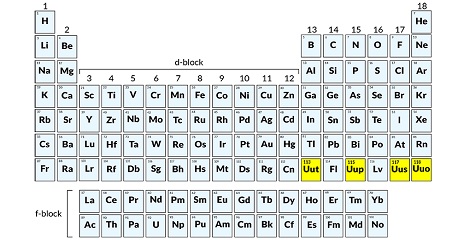The International Union of Pure and Applied Chemistry (IUPAC) has officially confirmed the permanent addition of four new elements to the periodic table.
- The announcement has been made that all four elements with atomic number 113, 115, 117 and 118 have met the criteria for discovery.
- The addition of these new elements also completes the seventh row of the periodic table.
- Riken Institute in Japan has been credited for the discovery of element 113 and it becomes the first element to be named by researchers in Asia.

Temporary working names & symbols of newly discovered elements
Element 113 (ununtrium, Uut)
- The RIKEN collaboration team in Japan have fulfilled the criteria for element Z=113 and will be invited to propose a permanent name and symbol.
Elements 115, 117, and 118 (ununpentium, Uup; ununseptium, Uus and ununoctium, Uuo)
- The collaboration between the Joint Institute for Nuclear Research in Dubna, Russia; Lawrence Livermore National Laboratory, California, USA and Oak Ridge National Laboratory, Oak Ridge, Tennessee, USA have fulfilled the criteria for element Z=115, 117, 118 and will be invited to propose permanent names and symbols.
What is Periodic Table?
The periodic table aka Mendeleev’s table is a tabular arrangement of the chemical elements, ordered by their atomic number (number of protons in the nucleus), electron configurations and recurring chemical properties.
- The table also shows four rectangular blocks: s-, p- d- and f-block.
- The rows of the table are called periods & the columns are called groups.
- It was created in 1869 by Russian chemist Dmitri Mendeleev.
AffairsCloud Recommends Oliveboard Mock Test
AffairsCloud Ebook - Support Us to Grow
Govt Jobs by Category
Bank Jobs Notification